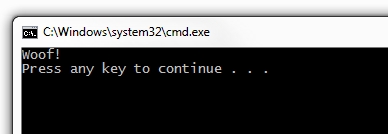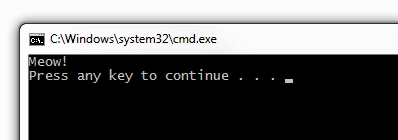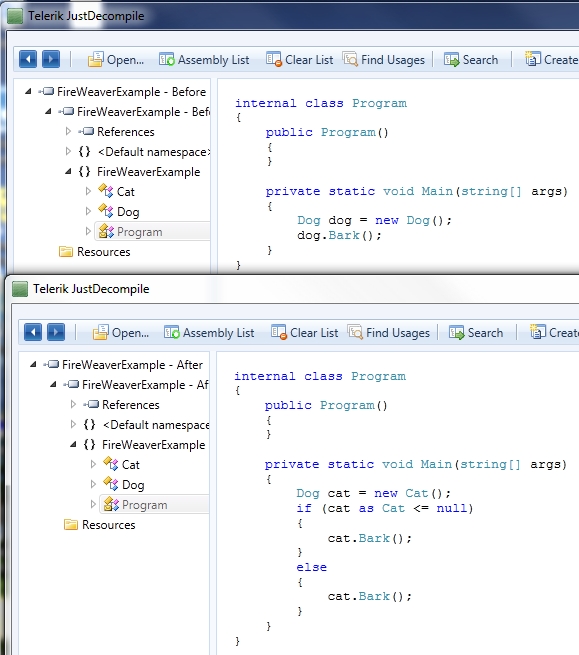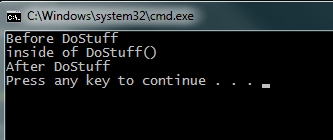Posts tagged with 'CIL'
Craig Stuntz is manipulating .NET IL. This episode is sponsored by Smartsheet.
Show Notes:
-
Craig Stuntz was the second guest I ever had on the show. Check out Podcast 002 - Craig Stuntz on Idris
-
Craig was at CodeMash presenting with these slides
-
RuJIT was mentioned
-
I dare you to keep these straight:
-
I don’t think he mentioned it by name, but I think Fizil is the fuzzer that he’s working on.
-
SQLite created by Dr. D. Richard Hipp
-
Mono.Cecil, part of the Mono project. DNLib is another similar tool.
-
Sure, I’ll plug my book again, since we mentioned AOP. AOP in .NET
-
Obfuscation is a technique to prevent people from reverse engineering/tampering with your code. Dotfuscator is one of the tools that comes to mind.
-
Blog post: "type erasure" in Java
-
Blog post: tail calls in F#
-
The "goat behind door number 2" is a reference to the Monty Hall Paradox (which is a great discussion topic for parties)
-
Book: .NET IL Assembler by Serge Lidin
-
ECMA 335 is the Common Language Infrastructure standard. I’d like to ecma-international.org, but their site seems to be broken at the moment.
-
Good ol' LINQPad
-
Meetup: Papers We Love Columbus
Want to be on the next episode? You can! All you need is the willingness to talk about something technical.
Music is by Joe Ferg, check out more music on JoeFerg.com!
I've been trying on and off to figure out Mono.Cecil, and so far it's not very encouraging. It's a bit above my pay grade, it seems.
But all is not lost: I came across a tool while browsing NuGet called FireWeaver. It sits on top of Mono.Cecil, which means it does its work after compilation. It provides you with a way to replace a class with an entire other class. So it's not exactly intercepting or proxying classes, the way other AOP frameworks do: it flat out replaces it and is "essentially duct typing(sic) the entire object definition". I don't know if that's supposed to be "duct taping" or "duck typing", but I rather like the term "duct typing".
Here's a quick example of how it works, taken from the FireWeaver CodePlex site. First, I added FireWeaver with NuGet. Then I created a console app like this:
| using System; | |
| using Firecracker; | |
| namespace FireWeaverExample | |
| { | |
| class Program | |
| { | |
| static void Main(string[] args) | |
| { | |
| var obj = new Dog(); | |
| obj.Bark(); | |
| } | |
| } | |
| public class Dog | |
| { | |
| public void Bark() | |
| { | |
| Console.WriteLine("Woof!"); | |
| } | |
| } | |
| [Replace(typeof(Dog))] | |
| public class Cat | |
| { | |
| public void Bark() | |
| { | |
| Console.WriteLine("Meow!"); | |
| } | |
| } | |
| } |
Compile and run as normal and here's the output:

Next, run the FireWeaver.Bootstrapper.exe tool against your assembly/assemblies. In my case, my Replace class is in the same assembly as the class it's replacing, so my arguments are identical, but you could certainly specify another assembly as the second argument:
| C:\zproj\CCC\FireWeaverExample\FireWeaverExample\bin\Debug>FireWeaver.Bootstrapper.exe FireWeaverExample.exe FireWeaverExample.exe |
And here's the output of the console app after I ran FireWeaver.

And here's what the assemblies look like (decompiled) before and after FireWeaver. Warning, your head may explode:

I'm just as confused about Cecil looking at these JustDecompile screenshots as I was before. But I assure you, it does work.
There's definitely some potential here, since this is a pretty easy tool to use, and integrating FireWeaver into your build script(s) shouldn't be too difficult if you don't want to hit the command line after every build. And it almost looks like pure duck typing brought to C#.
But this could also lead to some really wild code if you aren't careful with it. "Dogs and cats living together, mass hysteria" code.
One of the problems with object-oriented programming that AOP aims to solve is excessive boilerplate. And there's no more stark example of excessive boilerplate than the use of INotifyPropertyChanged.
NotifyPropertyWeaver is a tool that adds an MSBuild task to your project. It will find all your implementations of INotifyPropertyChanged and rewrite the properties to do all the notification code for you. So you don't have to worry about mistyping that property name string, and you don't have to worry about refactoring when you rename or remove properties.
In this code example below, the first file is a typical implementation of INotifyPropertyChanged, done entirely by hand. Notice all the noise and duplication: explicit backing properties, multiple calls to NotifyPropertyChanged to account for the derived property, the use of a string that exactly matches the property names. And this is a class with only three properties. Imagine if you had a whole bunch more properties, and imagine the maintenance problem to add/remove/change one of the derived properties!
| // this is how your code might look without using notifypropertyweaver | |
| public class Person1 : INotifyPropertyChanged | |
| { | |
| public event PropertyChangedEventHandler PropertyChanged; | |
| private void NotifyPropertyChanged(string propertyName) | |
| { | |
| if (PropertyChanged != null) | |
| { | |
| PropertyChanged(this, new PropertyChangedEventArgs(propertyName)); | |
| } | |
| } | |
| string _givenName; | |
| public string GivenName | |
| { | |
| get { return _givenName; } | |
| set | |
| { | |
| if(value != _givenName) | |
| { | |
| _givenName = value; | |
| NotifyPropertyChanged("GivenName"); | |
| NotifyPropertyChanged("FullName"); | |
| } | |
| } | |
| } | |
| string _familyName; | |
| public string FamilyName | |
| { | |
| get { return _familyName; } | |
| set | |
| { | |
| if (value != _familyName) | |
| { | |
| _familyName = value; | |
| NotifyPropertyChanged("FamilyName"); | |
| NotifyPropertyChanged("FullName"); | |
| } | |
| } | |
| } | |
| public string FullName | |
| { | |
| get | |
| { | |
| return string.Format("{0} {1}", GivenName, FamilyName); | |
| } | |
| } | |
| } |
The second file is an example of how you would do the exact same thing using NotifyPropertyWeaver. You don't have to write the NotifyPropertyChanged method, or call it in the setters, or write backing properties. This class is so much easier to read and maintain. The third file is actually a look at the class after it's been compiled, run through NotifyPropertyWeaver, and then disassembled with Telerik's JustDecompile. Look familiar? It's almost exactly the same as the hand-coded implementation.
| // this is how your code would look WITH using notifyproperty weaver | |
| public class Person2 : INotifyPropertyChanged | |
| { | |
| public event PropertyChangedEventHandler PropertyChanged; | |
| public string GivenName { get; set; } | |
| public string FamilyName { get; set; } | |
| public string FullName | |
| { | |
| get | |
| { | |
| return string.Format("{0} {1}", GivenName, FamilyName); | |
| } | |
| } | |
| } |
| // this is how the Person2 class looks when you decompile it | |
| public class Person2 : INotifyPropertyChanged | |
| { | |
| private PropertyChangedEventHandler PropertyChanged; | |
| public string FamilyName | |
| { | |
| get; | |
| set | |
| { | |
| if (string.Equals(this.<FamilyName>k__BackingField, value)) | |
| { | |
| return; | |
| } | |
| this.<FamilyName>k__BackingField = value; | |
| this.OnPropertyChanged("FullName"); | |
| this.OnPropertyChanged("FamilyName"); | |
| } | |
| } | |
| public string FullName | |
| { | |
| get | |
| { | |
| return string.Format("{0} {1}", this.GivenName, this.FamilyName); | |
| } | |
| } | |
| public string GivenName | |
| { | |
| get; | |
| set | |
| { | |
| if (string.Equals(this.<GivenName>k__BackingField, value)) | |
| { | |
| return; | |
| } | |
| this.<GivenName>k__BackingField = value; | |
| this.OnPropertyChanged("FullName"); | |
| this.OnPropertyChanged("GivenName"); | |
| } | |
| } | |
| public Person2() | |
| { | |
| } | |
| public virtual void OnPropertyChanged(string propertyName) | |
| { | |
| PropertyChangedEventHandler propertyChanged = this.PropertyChanged; | |
| if (propertyChanged != null) | |
| { | |
| base(new PropertyChangedEventArgs(propertyName)); | |
| } | |
| } | |
| public event PropertyChangedEventHandler PropertyChanged; | |
| } |
And finally, the fourth file is the change that will be made to your project file when you add NotifyPropertyWeaver with NuGet. It calls a task that uses Mono.Cecil to rewrite the code for you. You don't need to reference the build task DLL in your project.
| <!-- this is all that's added to your project --> | |
| <UsingTask TaskName="NotifyPropertyWeaverMsBuildTask.WeavingTask" AssemblyFile="$(SolutionDir)Tools\NotifyPropertyWeaverMsBuildTask.dll" /> | |
| <Target Name="AfterCompile"> | |
| <NotifyPropertyWeaverMsBuildTask.WeavingTask /> | |
| </Target> |
NotifyPropertyWeaver is a tool that does a single task, but this approach (an MSBuild post-compiler task) can be used to implement other AOP features. Fody is a tool by the creator of NotifyPropertyWeaver to do just that.
Recently I was made aware of another AOP tool for .NET that uses a post-compile step to do the weaving (similar to PostSharp). SheepAspect appears to use the Mono.Cecil library, which is a powerful utility to work with CIL assemblies. I mentioned SheepAspect in an earlier post, and I thought it deserved a closer look.
SheepAspect is available via NuGet, so it's an easy install. Here's a 'Hello, World' aspect in a console app that I threw together:
| using System; | |
| using SheepAspect.Attributes; | |
| using SheepAspect.Runtime; | |
| namespace SheepAspectExample | |
| { | |
| class Program | |
| { | |
| static void Main(string[] args) | |
| { | |
| var obj = new MyClass(); | |
| obj.DoStuff(); | |
| } | |
| } | |
| public class MyClass | |
| { | |
| public void DoStuff() | |
| { | |
| Console.WriteLine("inside of DoStuff()"); | |
| } | |
| } | |
| [Aspect] | |
| public class HelloWorldAspect | |
| { | |
| [SelectMethods("Public & InType: 'SheepAspectExample.MyClass'")] | |
| public void MyPointcut() {} | |
| [Around("MyPointcut")] | |
| public object InterceptMethod(MethodJointPoint jp) | |
| { | |
| Console.WriteLine("Before {0}", jp.Method.Name); | |
| var result = jp.Execute(); | |
| Console.WriteLine("After {0}", jp.Method.Name); | |
| return result; | |
| } | |
| } | |
| } |
It's a somewhat unfamiliar approach to me, being used to PostSharp.
- To define an aspect, create a class and put the [Aspect] attribute on it. So far so good.
- You don't use attributes to apply the aspect to your code. Notice that MyClass and DoStuff are not decorated with any attributes.
- Instead, you define a pointcut by creating an empty "marker" method (MyPointcut in the above example), and placing a selector attribute on that. The one I'm using is SelectMethods, but there are others available.
- The string in that SelectMethods attribute is called SheepAop Query Language (SAQL).
- The advice goes into the InterceptMethod method, which returns an object and gets an MethodJointPoint (yes MethodJointPoint, not MethodJoinPoint, that's not a typo). MethodJointPoint is very similar to DynamicProxy's IIntercept or PostSharp's MethodInterceptionArgs, in that it gives you a context to work with.
- I put an "Around" attribute on this method to specify that I want this advice to surround the pointcut, and I specified the pointcut with the string.
Compile and run, and here's the output:

After using SheepAspect in this admittedly trivial way, I do think it has some potential, but it also feels like a project that's in its very early stages and is a little rough around the edges still.
- SAQL is a very interesting way to select pointcuts, and based on the SAQL documentation that I've read, it can be very powerful. This is a double-edged sword though: this query language is specific to SheepAspect, so you'll have to spend some time learning it to get the most use out of it.
- SAQL queries are just strings, so refactoring/renaming could be problematic. Perhaps if you are coming from an AspectJ environment, this would not be as difficult, since that's what SheepAspect seems to modeled on. A Linq provider would be tremendous, but that might be very ambitious, if not impossible.
- The fact that SheepAspects are only connected to your regular code by SAQL is also an interesting approach: your pre-compile source code goes completely untouched, which is nice and clean, but it could also be hard to keep track of what aspects are being applied where.
- Finally, while there is some good documentation, it looks like some of it has yet to be written, which indicates to me that it's still very much a work in progress.
I can't say I'd recommend using SheepAspect over more mature and supported tools like PostSharp or Castle DynamicProxy, but it might be worth a look for specialized usage in low risk situations. In the future, who knows; it could develop into a very popular tool.

